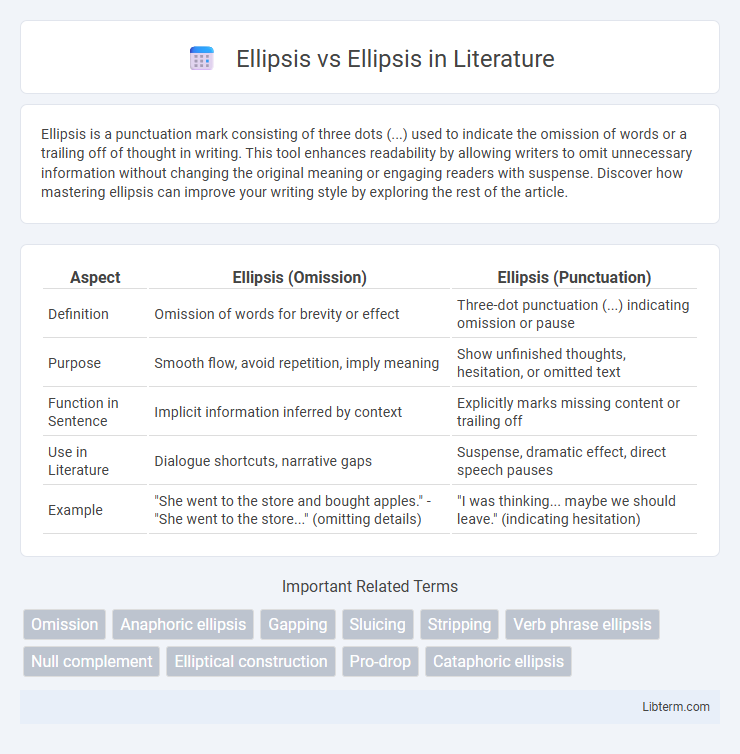Ellipsis is a punctuation mark consisting of three dots (...) used to indicate the omission of words or a trailing off of thought in writing. This tool enhances readability by allowing writers to omit unnecessary information without changing the original meaning or engaging readers with suspense. Discover how mastering ellipsis can improve your writing style by exploring the rest of the article.
Table of Comparison
| Aspect | Ellipsis (Omission) | Ellipsis (Punctuation) |
|---|---|---|
| Definition | Omission of words for brevity or effect | Three-dot punctuation (...) indicating omission or pause |
| Purpose | Smooth flow, avoid repetition, imply meaning | Show unfinished thoughts, hesitation, or omitted text |
| Function in Sentence | Implicit information inferred by context | Explicitly marks missing content or trailing off |
| Use in Literature | Dialogue shortcuts, narrative gaps | Suspense, dramatic effect, direct speech pauses |
| Example | "She went to the store and bought apples." - "She went to the store..." (omitting details) | "I was thinking... maybe we should leave." (indicating hesitation) |
Introduction to Ellipsis
Ellipsis is a linguistic phenomenon where parts of a sentence are omitted because they are understood from the context, enhancing communication efficiency. In grammar, ellipsis allows speakers to avoid repetition by leaving out elements like verbs or subjects when they are implied, such as in the sentence "She can dance, and he can [dance] too." This syntactic feature contributes to natural, concise dialogue and is essential for understanding sentence structure and meaning in both spoken and written language.
Defining Ellipsis in Grammar
Ellipsis in grammar refers to the intentional omission of one or more words from a sentence without altering the meaning, often to avoid redundancy and achieve concise expression. This linguistic feature allows speakers and writers to rely on context for clarity, as in the example "She can sing, and he can too," where "sing" is omitted after "can." Understanding ellipsis enhances comprehension and fluidity in both spoken and written communication, emphasizing the economy of language.
Types of Ellipsis in Language
Ellipsis in language involves the omission of words that are understood from the context, enhancing brevity and cohesion. Types of ellipsis include nominal ellipsis, where nouns are omitted ("She likes coffee, and he tea"), verbal ellipsis, which excludes verbs ("They can play the piano, but she can't"), and clausal ellipsis, omitting entire clauses ("If you want to go, I will too"). Understanding these types improves comprehension of natural language processing and syntactic analysis.
Ellipsis as a Punctuation Mark
Ellipsis as a punctuation mark consists of three dots (...) used to indicate omitted text, a trailing off thought, or a pause in dialogue. It improves clarity by signaling that part of a sentence or quotation has been left out, enhancing readability and maintaining original meaning. Commonly utilized in writing, editing, and digital communication, the ellipsis helps convey tone and pacing effectively.
Ellipsis in Writing: Usage Rules
Ellipsis in writing, represented by three consecutive dots (...), is used to indicate omitted text, create suspense, or convey trailing thoughts. Correct usage rules dictate that ellipses replace omitted material within quoted text without altering the original meaning, and spaces before and after each dot vary by style guides--such as MLA or APA guidelines requiring spaces between each dot. Proper use of ellipsis ensures clarity and maintains the reader's understanding while signaling intentional gaps or pauses in writing.
Common Misconceptions About Ellipsis
Ellipsis in grammar often causes confusion due to its dual definitions: it refers to both the omission of words for brevity and a punctuation mark of three dots indicating omitted text. Common misconceptions include treating all three-dot uses as ellipsis when some may signify hesitation or trailing thoughts in dialogue, not omission. Understanding the context of ellipsis in sentences clarifies its function, distinguishing between syntactic omission and punctuation signaling.
Ellipsis in Formal vs Informal Contexts
Ellipsis in formal contexts typically involves strategic omission of words to maintain clarity and conciseness in academic or professional writing, ensuring the sentence remains grammatically complete and easily understood. In informal contexts, ellipsis serves as a conversational tool, often indicating pauses, trailing thoughts, or omitted information for stylistic effect, enhancing natural speech flow and emotional tone. The semantic role of ellipsis varies with register, where formal usage emphasizes precision and economy, whereas informal usage allows flexibility and interpretative nuance.
Ellipsis in Creative and Professional Writing
Ellipsis in creative and professional writing serves as a powerful tool to convey pauses, unfinished thoughts, or a trailing off in dialogue, enhancing emotional depth and realism. It allows writers to create suspense, emphasize hesitation, or indicate omitted information without disrupting the flow, making texts more engaging and dynamic. Proper use of ellipsis can improve readability by signaling intentional breaks and fostering a conversational tone in both narrative and formal contexts.
Comparing Ellipsis: Grammar vs Punctuation
Ellipsis in grammar refers to the deliberate omission of words in a sentence to avoid redundancy while maintaining clarity, often indicated by context. In punctuation, the ellipsis is represented by three consecutive dots (...) used to show trailing off, pauses, or omitted text in quotations. Understanding the distinct roles of ellipsis in grammar and punctuation enhances precise writing and reading comprehension.
Conclusion: Clarifying Ellipsis Applications
Ellipsis in language refers primarily to the omission of words that are understood from context, enhancing sentence brevity and coherence in communication. The punctuation ellipsis--a series of three dots--signals omitted text or pauses, aiding in textual clarity and stylistic expression. Clarifying these applications ensures precise interpretation and effective usage across linguistic and editorial contexts.
Ellipsis Infographic

 libterm.com
libterm.com